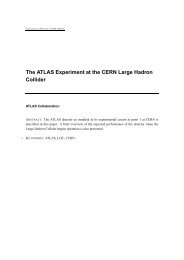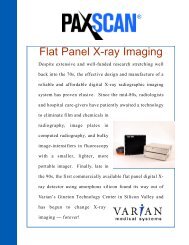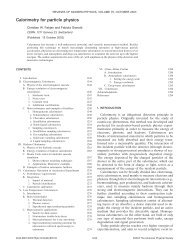(HDR) brachytherapy quality assurance - Biomedical Imaging and ...
(HDR) brachytherapy quality assurance - Biomedical Imaging and ...
(HDR) brachytherapy quality assurance - Biomedical Imaging and ...
Create successful ePaper yourself
Turn your PDF publications into a flip-book with our unique Google optimized e-Paper software.
DA Wilkinson. Biomed <strong>Imaging</strong> Interv J 2006; 2(2):e34 6This page number is notfor citation purposeFigure 8 Source position ruler showing white plastic indicator (red circle).Figure 9 Source position accuracy test showing a well-aligned ruler, transfer tube, <strong>and</strong> afterloader (left) <strong>and</strong> a setupwith a large curvature.TRAINING OF PERSONNELThe clinical personnel involved in an <strong>HDR</strong> programinclude the authorized user physician, authorized medicalphysicist, radiation safety officer, dosimetrist, nurse, <strong>and</strong>radiation therapy technologist. Some of these roles maybe combined into one. For example, the medicalphysicist may act also as the radiation safety officer <strong>and</strong>do the treatment planning in lieu of a dosimetrist. Theauthorized physician <strong>and</strong> medical physicist should becertified by the appropriate medical specialties board <strong>and</strong>have had special training in <strong>brachytherapy</strong>. Of primeimportance is the radiation safety training that allpersonnel involved in <strong>HDR</strong> treatments undergo. This isadministered to new personnel <strong>and</strong> then annually for allthose in the <strong>HDR</strong> program. Included is training in theproper response to a major emergency, in particular,failure of the source to be retracted into the after loadersafe upon completion of treatment or upon power outage.The daily spot check should ensure that properequipment (removal kit <strong>and</strong> bailout pig) is in place <strong>and</strong>that simple emergency instructions are posted so as to bereadily available. If the source has to be retractedmanually, the st<strong>and</strong>ard precepts of radiation safety, viz.time, distance, <strong>and</strong> shielding, should be followed. Ifoperation of the h<strong>and</strong> crank is unsuccessful, then theapplicator containing the stuck source has to be removedfrom the patient. Once again, speed is crucial as ishaving such items as long forceps <strong>and</strong> a flashlight onh<strong>and</strong>. With the applicator plus source placed in thebailout pig <strong>and</strong> the patient <strong>and</strong> medical personnelremoved from the treatment room, the <strong>HDR</strong> suite shouldbe secured <strong>and</strong> a service engineer contacted for repair.We find it useful at the time of the annual training toreview <strong>and</strong> discuss in detail what each member of our<strong>brachytherapy</strong> team would do in various emergencysituations.REFERENCES1. Corbett PJ. Brachytherapy in carcinoma of the cervix: The state ofthe art. Martinez AA, Orton CG, Mould RF, eds. Brachytherapy<strong>HDR</strong> & LDR. Columbia: Nucletron, 1990:100-9.2. U.S. Nuclear Regulatory Commission [Web Page]. Available athttp://www.nrc.gov.3. Nath R, Anderson LL, Meli JA, et al. Code of practice for<strong>brachytherapy</strong> physics: report of the AAPM Radiation TherapyCommittee Task Group No. 56. American Association ofPhysicists in Medicine. Med Phys 1997;24(10):1557-98.4. Kubo HD, Glasgow GP, Pethel TD, et al. High dose-rate<strong>brachytherapy</strong> treatment delivery: report of the AAPM RadiationTherapy Committee Task Group No. 59. Med Phys1998;25(4):375-403.















